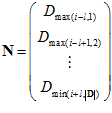
Patch Normalization for Visual Template Matching based on Panoramic Images in Bio-inspired Navigation System
The excerpt note is about how to enhance the signal-to-noise ratio by using patch normalization in each image to enhance edge information and eliminate image intensity variation from Edward P. et al. IJRR 2016.
Patch normalization is performed by dividing an image into a grid of square patches and for each pixel, subtracting the patch mean and then dividing by the patch standard deviation. Finally, a mean difference score,  , is calculated for each query-database image pair by calculating the
, is calculated for each query-database image pair by calculating the  -norm with the Sum of Absolute Difference (SAD) metric
-norm with the Sum of Absolute Difference (SAD) metric


Where  returns a central
returns a central  region of the image, and
region of the image, and  returns a
returns a  region of the image, offset by
region of the image, offset by  from the center, where
from the center, where  and
and  , and
, and  and
and  are the dimensions of the low-resolution, patch-normalized grayscale images. We compare central subregions of
are the dimensions of the low-resolution, patch-normalized grayscale images. We compare central subregions of  and
and  over a range of offsets up to horizontal and vertical maxima (
over a range of offsets up to horizontal and vertical maxima ( and
and  , respectively), such that the SAD score of the overlapping region is minimized. As each query frame is compare with all database frames using SAD, we form a difference vector,
, respectively), such that the SAD score of the overlapping region is minimized. As each query frame is compare with all database frames using SAD, we form a difference vector,  , for each frame.
, for each frame.
Lastly, we modify the raw difference scores by considering that we are searching for coherent sequences of locally-best image matches.
Hence, the local matching contrast is enhanced by normalizing each element  in the difference vector
in the difference vector  within a neighbourhood centered around it
within a neighbourhood centered around it

Where  and
and  are the mean and standard deviation of the neighbourhood vector, respectively
are the mean and standard deviation of the neighbourhood vector, respectively

Where  is defined by a neighbourhood radius parameter,
is defined by a neighbourhood radius parameter,  , and bounded by the length of
, and bounded by the length of  . This process gives the normalized difference vector,
. This process gives the normalized difference vector,  .
.
References:
Pepperell, Edward, Peter Corke, and Michael Milford. “Routed roads: Probabilistic vision-based place recognition for changing conditions, split streets and varied viewpoints.” The International Journal of Robotics Research 35, no. 9 (2016): 1057-1179.
About
Brain Inspired Navigation Blog
New discovery worth spreading on brain-inspired navigation in neurorobotics and neuroscience
Recent Posts
- How human, animals, robots encode and recall place?
- How the brain constructs time and space and how these are related to episodic memory?
- How environmental novelty modulate rapid cortical plasticity during navigation?
- How the Hippocampal Cognitive Map Supports Flexible Navigation?
- How the geometric structure and underlying circuit organization of hippocampal population dynamics facilitate both memory discrimination and generalization, enabling efficient and flexible learning?
Tags
Categories
- 3D Movement
- 3D Navigation
- 3D Path Integration
- 3D Perception
- 3D SLAM
- 3D Spatial Representation
- AI Navigation
- Bio-Inspired Robotics
- Brain Inspired Localization
- Brain-Inspired Navigation
- Cognitive Map
- Cognitive Navigation
- Episodic Memory
- Excerpt Notes
- Flying Vehicle Navigation
- Goal Representation
- Insect Navigation
- Learning to Navigate
- Memory
- Neural Basis of Navigation
- Path Integration
- Path Planning
- Project
- Research Tips
- Robotic Vision
- Self-Flying Vehicles
- Semantic Memory
- Spatial Cognition
- Spatial Cognitive Computing
- Spatial Coordinate System
- Spatial Learning
- Spatial Memory
- Spatial Resoning
- Time
- Unclassified
- Visual Cortex
- Visual Cue Cells
Links
- Laboratory of Nachum Ulanovsky
- Jeffery Lab
- BatLab
- The NeuroBat Lab
- Taube Lab
- Laurens Group
- Romani Lab
- Moser Group
- O’Keefe Group
- DoellerLab
- MilfordRobotics Group
- The Space and Memory group
- Angelaki Lab
- Spatial Cognition Lab
- McNaughton Lab
- Conradt Group
- The Fiete Lab
- The Cacucci Lab
- The Burak Lab
- Knierim Lab
- Clark Spatial Navigation & Memory Lab
- Computational Memory Lab
- The Dombeck Lab
- Zugaro Lab
- Insect Robotics Group
- The Nagel Lab
- Basu Lab
- Spatial Perception and Memory lab
- The Neuroecology lab
- The Nagel Lab
- Neural Modeling and Interface Lab
- Memory and Navigation Circuits Group
- Neural Circuits and Memory Lab
- The lab of Arseny Finkelstein
- The Epstein Lab
- The Theoretical Neuroscience Lab
- Gu Lab (Spatial Navigation and Memory)
- Fisher Lab (Neural Circuits for Navigation)
- The Alexander Lab (Spatial Cognition and Memory)
- Harvey Lab (Neural Circuits for Navigation)
- Buzsáki Lab
- Brain Computation & Behavior Lab
- ……